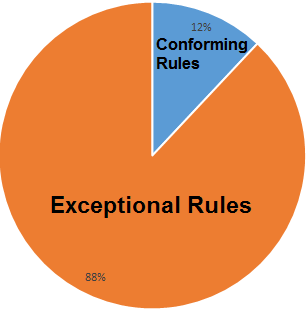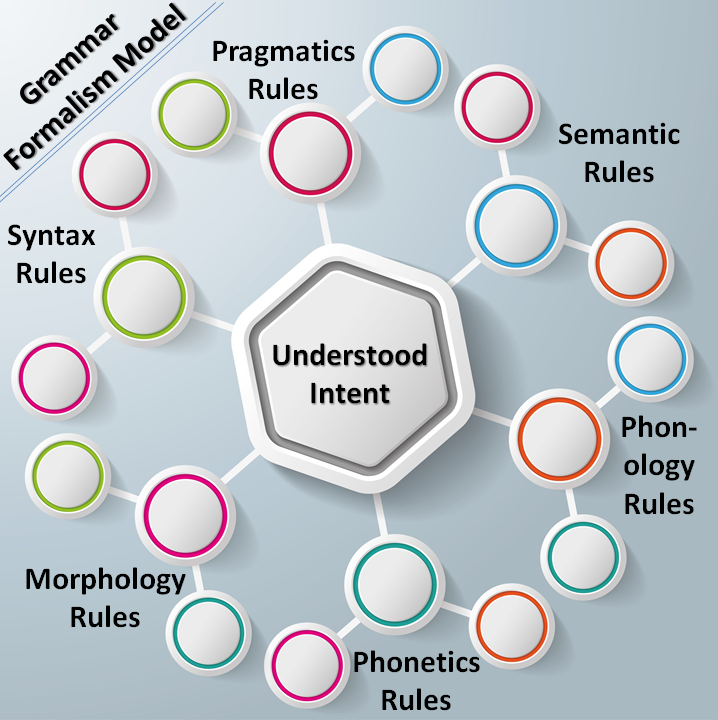30 Apr Exceptional Logic
 Exceptions to the Rules
Exceptions to the Rules
In natural language, exceptions to rules of grammar and other characteristics are frequent, and exhibit little consistency or predictability. They may multiply in discourse and in situations where the speaker/writer’s competence is limited. Idioms and irregular verbs are common exceptions which can be quite difficult to categorize or describe using formal descriptive grammar. Further exceptions can be expected when language is viewed as dynamic and changeable, rather than the uncompromising domain of the language purist.
For example, intransitive verbs in English do not take objects. Sneeze is an intransitive verb. “Fred sneezed a mouthful of food across the table” is a perfectly understandable sentence, despite its deviant structure. If we substituted “propelled” for “sneezed,” the sentence would conform to established rules, but the original meaning would be lost. Fortunately, natural language has a wonderful flexibility that permits deviation. Deviation (mutation, adaptation and natural selection), in fact, is how each language evolved to its present form, with each step, advancing from forbidden logic, to exceptional logic to accepted standard.
| Understanding Context Cross-Reference |
|---|
| Click on these Links to other posts and glossary/bibliography references |
|
|
|
| Prior Post | Next Post |
| The Multiple Meanings of Polysemy | Traditional Grammar from the Top Down |
| Definitions | References |
| exceptions rules | Huang 2007 |
| idiom grammar | Soames 1979 |
| intent ambiguity | Graesser 1990 |
 For automated systems intent on determining the intent of the original text, the resolution of ambiguity, fault-tolerance, and exception protocol efficacy are measures of robustness. To achieve robustness in a natural language system, we need a method for dealing with exceptions.
For automated systems intent on determining the intent of the original text, the resolution of ambiguity, fault-tolerance, and exception protocol efficacy are measures of robustness. To achieve robustness in a natural language system, we need a method for dealing with exceptions.
The ratio of rules to exceptions in the English language is shown at right with rules in blue and exceptions in red. This is completely fictitious. Nobody could possibly know or quantify the exact ratio. This is just intended to illustrate the point.
Who Needs Grammar?
For computerized interpretation, we need to adopt a grammar formalism. In this sense, a grammar can be regarded as a theory of language. “When two grammars make different empirical predictions about the language, we obviously choose the grammar that makes the correct predictions,” say Soames & Perlmutter (1979, p.35), describing the “theory-external” grounds for selecting a grammar. “Theory-internal” grounds for choosing a grammar are possible when more than one grammar correctly predict empirical results.
What if no grammar provides a suitable model? Due to the difficulties of most existing grammars to support high-quality computerized language interpretation or translation, the best option may be to create a new grammar. Of course, we do not know if the weakness is in the grammar or in the algorithm that implements the grammar. Still, the tremendous amount of work and money that have been poured into natural language interpretation and translation have not yet delivered some of the hoped-for products.
The absence of truly high-quality automated translation suggests that the old models are not suitable. 3-DG seeks not to do away with grammar, but to combine best-of-breed approaches from among a huge selection of possibilities to craft a system that can disambiguate polysemy at all levels. Soames & Perlmutter explain why, after a formalism is chosen or designed, rules must be selected:
“Although it is often difficult to decide just which phrase structure rules a grammar should include, the purpose of these rules is clear. They are needed to produce underlying structures. The way to justify a particular phrase structure rule is to show that it is needed to generate the underlying structure of some well-formed sentence” (1979). My goal is to go beyond the “underlying structure” to the “underlying intent.” As such, I need a formalism that supports rules across multiple language strata, and one that treats exceptions the same as conforming rules, but provides mechanisms to constrain the contexts in which the exceptions apply.
Although it is necessary to test the formalism and its rules, it’s impossible to prove that the formalism is either complete or correct unless you can generate all the permutations of possible utterances. You can infer that the formalism is correct if, each time you encounter another situation where the rules fail, you can easily add a well-formed rule to handle that situation and the new rule works. The most suitable formalisms are the ones that are both infinitely adaptable, and efficient (speedy) in processing, yet they return consistently reliable results. For a multi-lingual, multi-directional translator, containing rules that span the range of language strata, this is a very tall order, yet it is necessary.
This is why an ontology framework, in which context can define, for each rule or set of rules, the applicable language dimension or stratum, is the approach I have adopted.
| Click below to look in each Understanding Context section |
|---|
| Intro | Context | 1 | Brains | 2 | Neurons | 3 | Neural Networks |
| 4 | Perception and Cognition | 5 | Fuzzy Logic | 6 | Language and Dialog | 7 | Cybernetic Models |
| 8 | Apps and Processes | 9 | The End of Code | Glossary | Bibliography |









